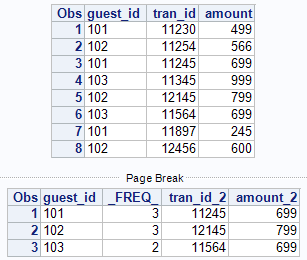- Home
- /
- Programming
- /
- SAS Procedures
- /
- how to get second transcation of guest
- RSS Feed
- Mark Topic as New
- Mark Topic as Read
- Float this Topic for Current User
- Bookmark
- Subscribe
- Mute
- Printer Friendly Page
- Mark as New
- Bookmark
- Subscribe
- Mute
- RSS Feed
- Permalink
- Report Inappropriate Content
data test;
input guest_id tran_id amount;
datalines
101 11230 499
102 11254 566
101 11245 699
103 11345 999
102 12145 799
103 11564 699
101 11897 245
102 12456 600
;
run
i need guest second transaction details only for each guest.
AS
101 11230 499
102 11254 566
101 11245 699------1
103 11345 999
102 12145 799------2
103 11564 699------3
101 11897 245
102 12456 600
This three records need to be as output
Please help me Out.
Thanks in advance..!
- Mark as New
- Bookmark
- Subscribe
- Mute
- RSS Feed
- Permalink
- Report Inappropriate Content
data test;
input guest_id tran_id amount;
datalines;
101 11230 499
102 11254 566
101 11245 699
103 11345 999
102 12145 799
103 11564 699
101 11897 245
102 12456 600
;
run;
proc sort data=test;
by guest_id tran_id;
run;
data new (drop=secondObsflag);
set test;
by guest_id;
retain secondObsflag;
if first.guest_id then secondObsflag=0;
if secondObsflag = 1 then output;
secondObsflag +1;
run;
- Mark as New
- Bookmark
- Subscribe
- Mute
- RSS Feed
- Permalink
- Report Inappropriate Content
Just as a code variation:
data test;
input guest_id tran_id amount;
datalines;
101 11230 499
102 11254 566
101 11245 699
103 11345 999
102 12145 799
103 11564 699
101 11897 245
102 12456 600
;
run;
proc sort data=test;
by guest_id tran_id;
run;
data new (drop=_:);
set test;
by guest_id;
_count+1;
if _count=2 then output;
if last.guest_id then _count=0;
run;
- Mark as New
- Bookmark
- Subscribe
- Mute
- RSS Feed
- Permalink
- Report Inappropriate Content
Hello,
With proc transpose:
data test;
input guest_id tran_id amount;
datalines;
101 11230 499
102 11254 566
101 11245 699
103 11345 999
102 12145 799
103 11564 699
101 11897 245
102 12456 600
;
run;
proc sort data=test out=testsorted;
by guest_id;
run;
proc transpose data=testsorted out=tr1;
by guest_id ;
var tran_id amount ;
run;
proc transpose data=tr1 out=want (drop=_name_);
by guest_id;
id _name_;
var col2;
run;
- Mark as New
- Bookmark
- Subscribe
- Mute
- RSS Feed
- Permalink
- Report Inappropriate Content
The simple way is proc sort . The efficient way is Hash Table.
data test;
input guest_id tran_id amount;
datalines;
101 11230 499
102 11254 566
101 11245 699
103 11345 999
102 12145 799
103 11564 699
101 11897 245
102 12456 600
;
run;
proc sort data=test ;by guest_id;run;
data want;
set test;
by guest_id;
if first.guest_id then n=0;
n+1;
if n=2;
run;
data test;
input guest_id tran_id amount;
datalines;
101 11230 499
102 11254 566
101 11245 699
103 11345 999
102 12145 799
103 11564 699
101 11897 245
102 12456 600
;
run;
data want1;
if _n_ eq 1 then do;
if 0 then set test;
declare hash ha();
ha.definekey('guest_id') ;
ha.definedata('n');
ha.definedone();
end;
set test;
if ha.find()=0 then do;
n+1;
ha.replace();
if n=2 then output;
end;
else do;n=1;ha.add();end;
run;
Xia Keshan
- Mark as New
- Bookmark
- Subscribe
- Mute
- RSS Feed
- Permalink
- Report Inappropriate Content
proc sql;
create table want as
select * from
(select * from test group by guest_id having tran_id>min(tran_id))
group by guest_id
having tran_id=min(tran_id);
quit;
- Mark as New
- Bookmark
- Subscribe
- Mute
- RSS Feed
- Permalink
- Report Inappropriate Content
input guest_id $ tran_id amount;
datalines;
101 11230 499
102 11254 566
101 11245 699
103 11345 999
102 12145 799
103 11564 699
101 11897 245
102 12456 600
;;;;
run;
proc print;
run;
proc summary data=test nway;
class guest_id;
output out=second(drop=_type_ tran_id_1 amount_1)
idgroup(min(tran_id) out[2](tran_id amount)=);
run;
proc print;
run;

- Mark as New
- Bookmark
- Subscribe
- Mute
- RSS Feed
- Permalink
- Report Inappropriate Content
If your data are already sorted by tran_id, the following might be the fastest solution:
data test;
input guest_id tran_id amount;
datalines;
101 11230 499
102 11254 566
101 11245 699
103 11345 999
102 12145 799
103 11564 699
101 11897 245
102 12456 600
;
data want;
set test;
array allguests(9999999) _temporary_;
allguests(guest_id)+1;
if allguests(guest_id) eq 2 then output;
run;
- Mark as New
- Bookmark
- Subscribe
- Mute
- RSS Feed
- Permalink
- Report Inappropriate Content
Hi. Arthur.T ,
What if guest_id was character type variable ?
- Mark as New
- Bookmark
- Subscribe
- Mute
- RSS Feed
- Permalink
- Report Inappropriate Content
If it contains both alpha and numeric then, of course, my proposed code wouldn't work. If all of the values were numbers, though, simply including an input function would suffice.
I offered the code because I'm concerned about the limitations of the proc summary method. How many levels can it handle these days?
April 27 – 30 | Gaylord Texan | Grapevine, Texas
Registration is open
Walk in ready to learn. Walk out ready to deliver. This is the data and AI conference you can't afford to miss.
Register now and lock in 2025 pricing—just $495!
Learn the difference between classical and Bayesian statistical approaches and see a few PROC examples to perform Bayesian analysis in this video.
Find more tutorials on the SAS Users YouTube channel.
SAS Training: Just a Click Away
Ready to level-up your skills? Choose your own adventure.





